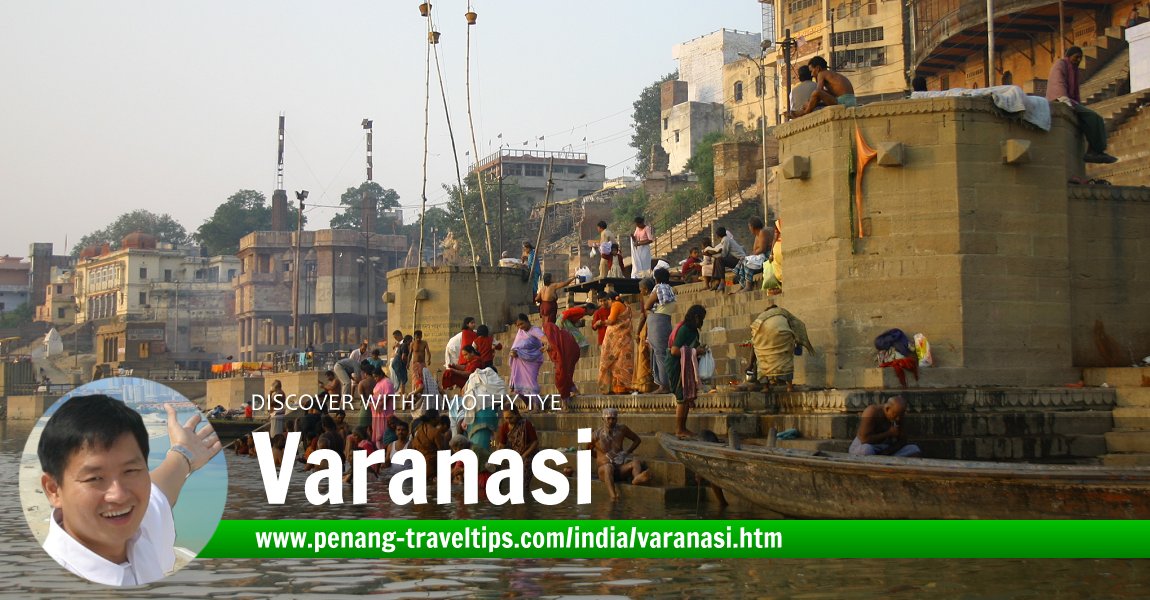 Varanasi (16 November, 2004)
Varanasi (16 November, 2004)
Varanasi provides you information to plan a visit to Varanasi, the ancient city and pilgrimage site in Uttar Pradesh, India. For many Hindus stands as the ultimate pilgrimage site. Although nobody really knows when Varanasi was founded, the city has been documented as one of the oldest continuously inhabited city in the world. Variations to the spelling of Varanasi includes Banaras, Benares and Benaras. These were frequently used during the British administration, and indeed older books continue to show it as Benares. Today, however, only Varanasi and sometimes Banaras is commonly used.
The city of Varanasi covers 1,550 sq km (600 sq mi) and has a population of 3.7 million people (2012 estimate). It is located in the state of Uttar Pradesh, India.
Places of Interest in Varanasi
Varanasi is enchanting at different times of the day. I particularly enjoy exploring it at night, so I wrote a page on Exploring Varanasi at Night too.
About Varanasi
Varanasi derives its name from two streams, the Varuna on the north of the city, and the Assi, a small trickle on the South. According to legend, the Varuna and Assi rivers originated from the body of the primordial person at the beginning of time. Varanasi is also known to the Hindus as Kashi, which means City of Light, and it is regarded as one of the seven Sacred Cities of Hinduism. The word Kashi originated from the word "kas", which means to shine. Varanasi is said to combine all the virtues of other pilgrimage sites, and anyone dying within the area marked by the Panch Kosi Road is believed to be transported straight to heaven.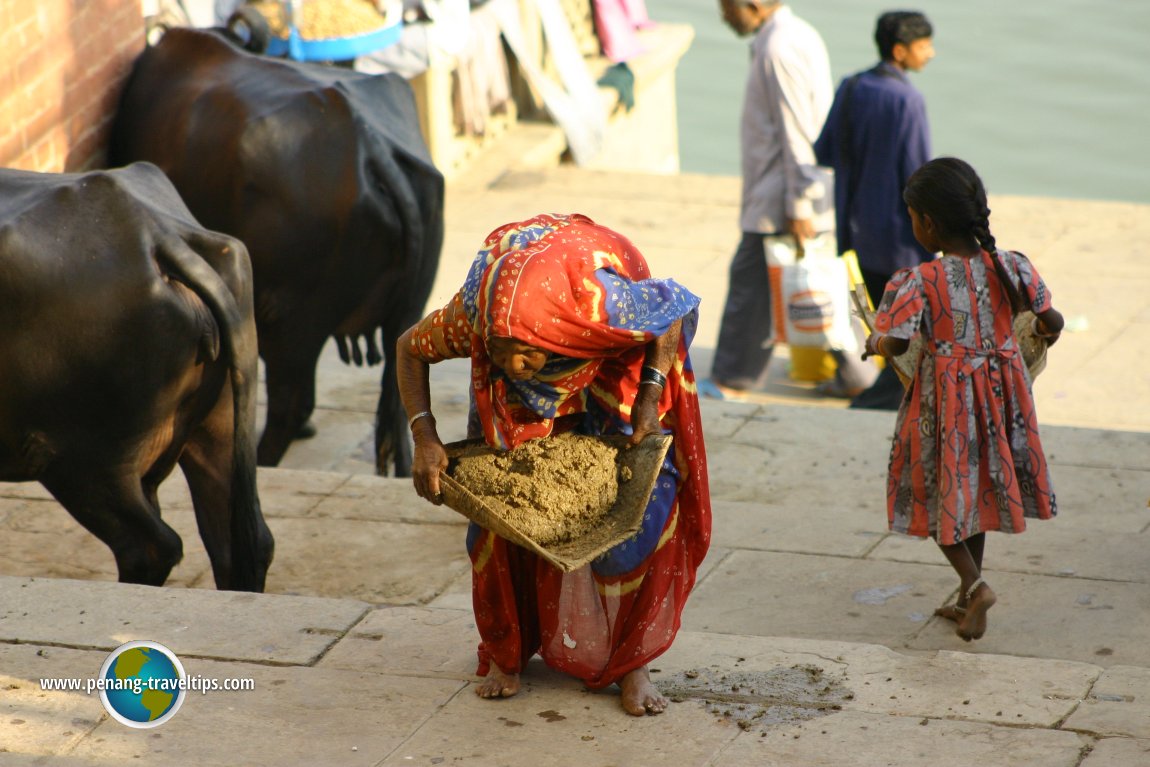 A wizened old lady collecting dung from the steps of a ghat in Varanasi (15 November 2004)
A wizened old lady collecting dung from the steps of a ghat in Varanasi (15 November 2004)
History of Varanasi
The history of Varanasi is shrouded in the fog of time. According to myth, Varanasi was founded by the Hindu deity Shiva. For that reason, it is one of the most important pilgrimage sites in Hinduism. With many ancient text mentioning the city, suggesting that it has already been inhabited over 5000 years ago, Varanasi lays claim as being the oldest continuously inhabited city in the world.Varanasi was occupied by the Muslims from the 11th century, when it was conquered by Mahmud of Ghazni in 1033. This resulted in the destruction of all its Hindu temples. The stones were taken from the temples to build mosques. Only in the 16th century, under the Mughal emperor Akbar was the freedom to worship relaxed. But this was shortlived, for under the reign of Emperor Aurangzeb, Hindus once again faced persecution. A Muslim zealot, Aurangzeb renamed Varanasi Mohammadabad. Varanasi was only unshackled of its Mughal overlords by the Marathas, a group of warrior-class Hindus, in the 18th century. It became an independent kingdom in the 18th century, only to fall under British rule in the subsequent century, and was absorbed as one of the cities of the state of Uttar Pradesh in the independent Republic of India.
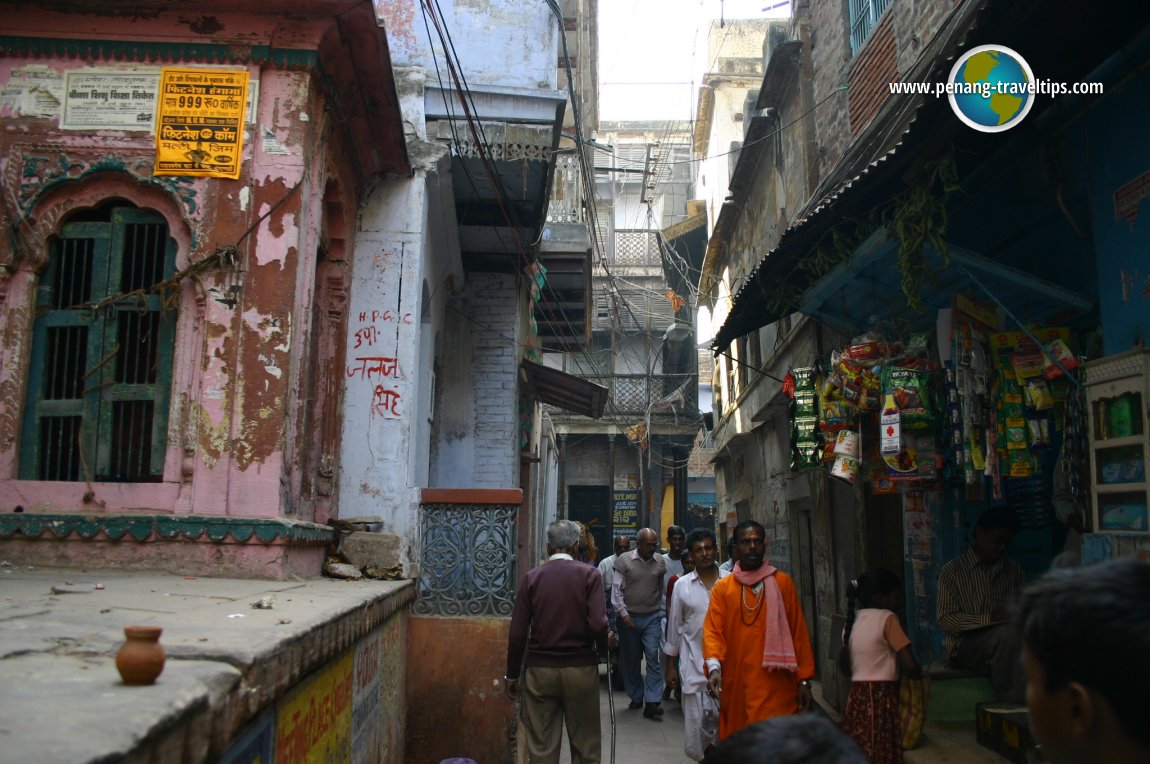 One of the busy gali in Varanasi. (16 November 2004)
One of the busy gali in Varanasi. (16 November 2004)
Varanasi Geography
Varanasi is located on a curve of the Ganges. Like Varanasi, the Ganges is considered one of the holiest rivers in Hinduism. It is on the eastern part of the state of Uttar Pradesh. To arrive in Varanasi, I took an overnight train from Delhi, along with three other members of AsiaExplorers.Varanasi Climate
From personal experience, I can say that Varanasi is pretty hot, even in November, when I visited, hotter than Delhi, and certainly much hotter than Kashmir. This is especially so during the afternoon, which was when I explored the banks of the Ganges. I learn that the temperature only starts to drop between December and February, when the cold waves blows down from the Himalayan mountains. Fog is common in winter. In summer, a hot dry wind called loo further dehydrates the city.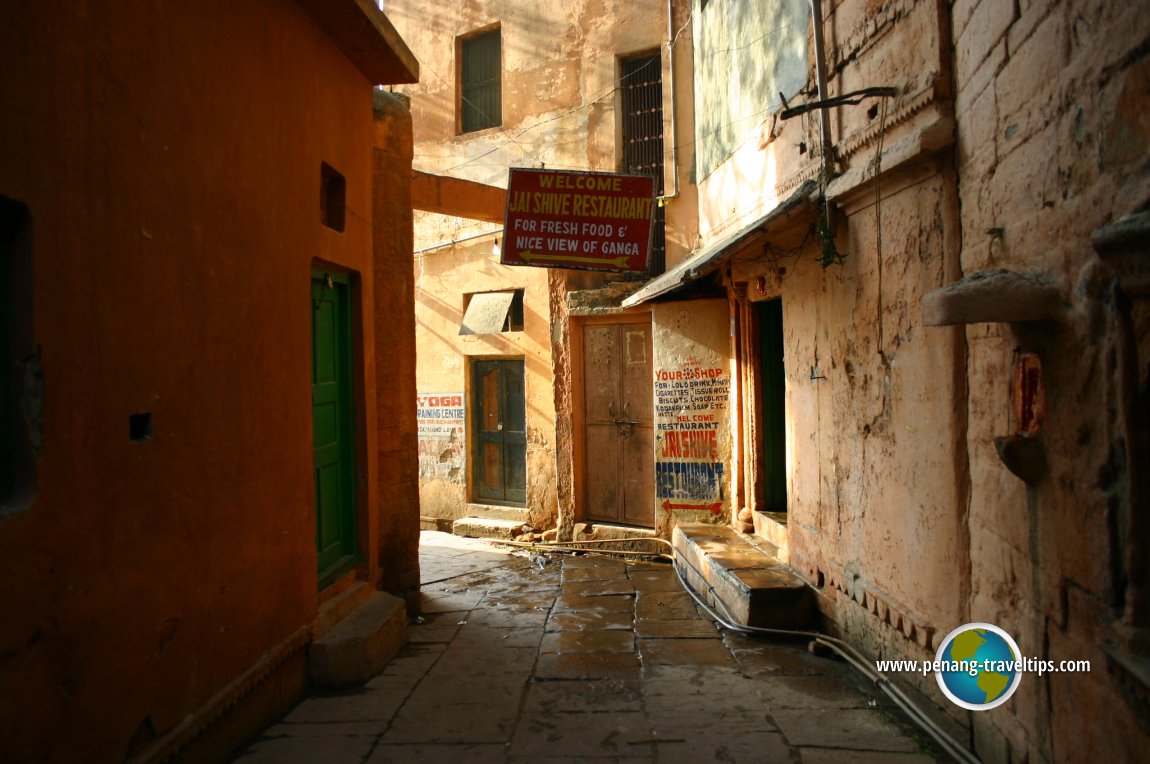 An alley in Varanasi near the ghats. (15 November 2004)
An alley in Varanasi near the ghats. (15 November 2004)
Getting there
Varanasi is most easily approached by train. There are regular train services between Delhi and Varanasi. It can also be reached by train from Agra and Mumbai. The train journey from Delhi departs in the evening and arrives the following morning. There are two railway stations serving Varanasi. The Varanasi Junction station is located at the heart of the city, and is just a short rickshaw ride from the ghats. To buy your train ticket online, go to the IR Online Passenger Reservation Site (https://www.irctc.co.in/).You can also fly to Varanasi from Delhi. The Varanasi Airport (VNS), 25 km outside the city, is served by Indian Airlines, Air Sahara, Jet Airways, Kingfisher Airlines and SpiceJet, among others.
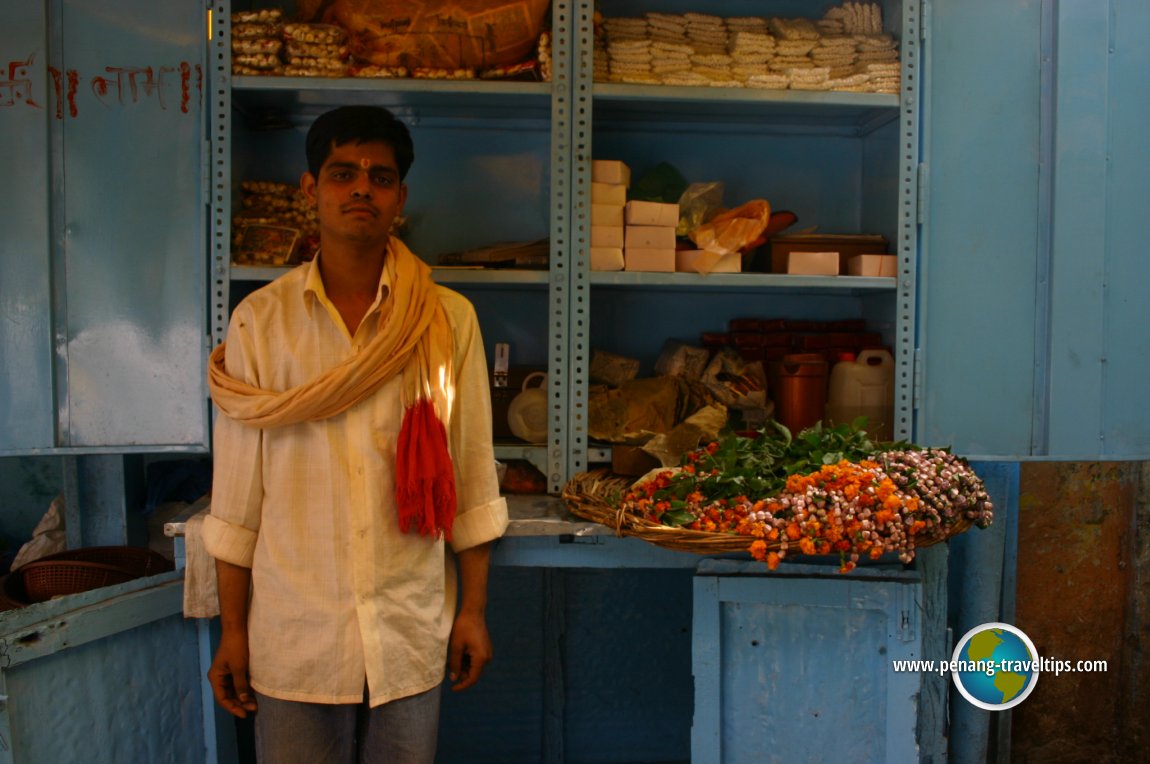 A Varanasi flower vendor (16 November 2004)
A Varanasi flower vendor (16 November 2004)
Getting Around Varanasi
There are auto rickshaws as well as "manpowered" rickshaws. Bargain and determine price before you climb on board, and even then, the rickshaw rivers will try to take advantage of you if they can. As earlier mentioned, you can come to Varanasi from Delhi by train. The auto-rickshaw ride from the Varanasi Junction railway station to Dashaswamedh Ghat should cost you between Rs 20 and Rs 30.The best way to explore the ghats along the Ganges is on foot. It provides you the opportunity to view the life in Varanasi up close and at an unhurried pace. You can also hire a boat to take you along the Ganges river. The price, if you are very good at bargaining, should be around Rs 30 per hour per boat. In any case, be prepared to pay Rs 50 for a small boat up to Rs 125 for a large boat. Prices are per boat, not per person. Prices tend to be higher at dawn, when most of the tourist are out looking for boats to see the Varanasi sunrise.
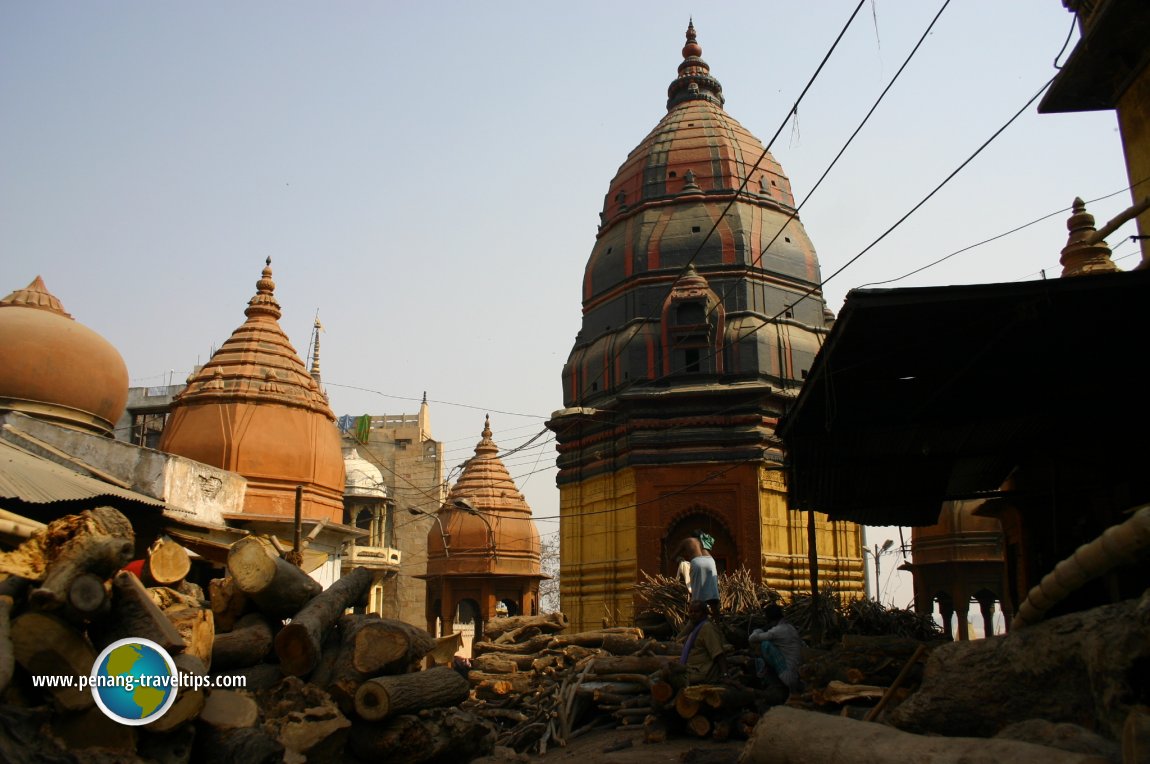 Firewood at the Manikarnika Ghat, Varanasi (16 November 2004)
Firewood at the Manikarnika Ghat, Varanasi (16 November 2004)
Pilgrimages to Varanasi
Throngs of Hindus from around the world converge on Varanasi every day, although on a normal day, the ghats are pretty quiet during the afternoon, and you'd only see the locals by the banks of the Ganges, whether doing their laundry, bathing, repairing their boats, herded lifestock, or simply idling. Most of the pujas happen at dawn and after sunset, when the banks of the Ganges becomes crowded with worshippers and tourists.Apart from Hindus, Buddhists also come to Varanasi because it is a mere 13 km from Sarnath, one of the holiest sites for Buddhists, for it is where Buddha is said to have preached his first sermon after achieving Enlightenment.
 Exploring the labyrinth of galis in Varanasi (16 November 2004)
Exploring the labyrinth of galis in Varanasi (16 November 2004)
Varanasi Travelogue
To be in Varanasi is in itself an experience, and for some, a journey of self discovery. I had the great privilege of visiting Varanasi in November 2004. I must tell you, Varanasi is an experience like no other city I have been before or since. Following an overnight journey from Delhi, we arrived at the Varanasi Railway Station, and then got a motor ricksaw to take us into the heart of Varanasi. There were four of us, all members of AsiaExplorers. There, within the labyrinth of alleyways, we booked into a guest house within walking distance of the Ganges river. We stayed in Varanasi for three days and two nights, and discovering a few days in the life by the banks of the holiest river in Hinduism.A great part of the city of Varanasi consists of the labyrinthine alleyways. It is easy to get lost in the labyrinth, and I am sheepish to say that I did get lost once as well, though I prided myself for usually having a good sense of direction. It took me close to an hour of desperate retracing of my steps to get back to surroundings that looked familiar.
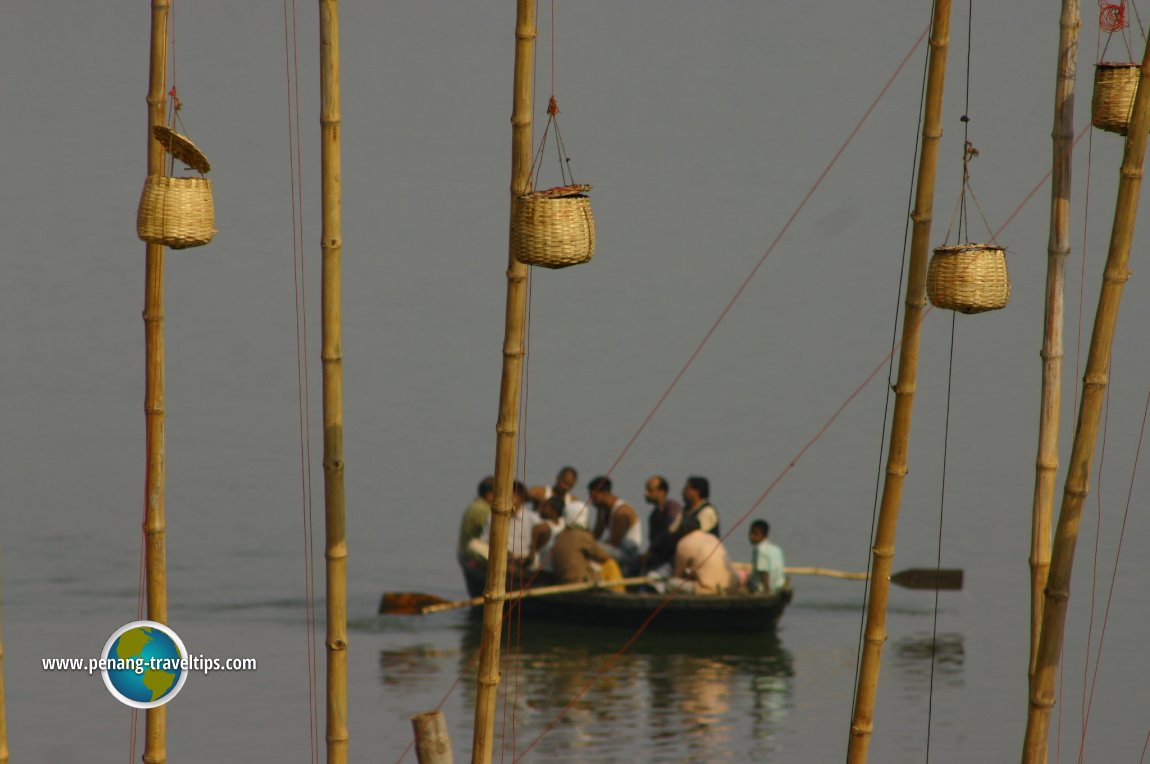 A ferryboat carrying passengers across the Ganges in Varanasi (16 November 2004)
A ferryboat carrying passengers across the Ganges in Varanasi (16 November 2004)
The main streets are hot, dusty, and congested with all forms of vehicular traffic, punctuated with pedestrians with seeming death wishes and mingled with loitering cows. The alleys, provide much sought-after shade and a great escape from the relentless Varanasi sun. Within the coolness of these Varanasi alleys are guesthouses where budget travellers like myself found accommodation. As soon as you step into one of these guesthouses, you immediately leave behind the din and congestion of the alleys and streets. Here you find a sanctuary away from all the noise and the heat.
The cows were everywhere in Varanasi. Even in the narrowest Varanasi alley, you would bump into them. I am not sure whether they have owners, but they don't seem to. Anyway, their presence cause most of the alley to carry a stench from the combination of rotten fruits and vegetables mixed with the cow dung, human urine and excrement. As I mentioned, Varanasi is quite an experience, and certainly not for the faint-hearted.
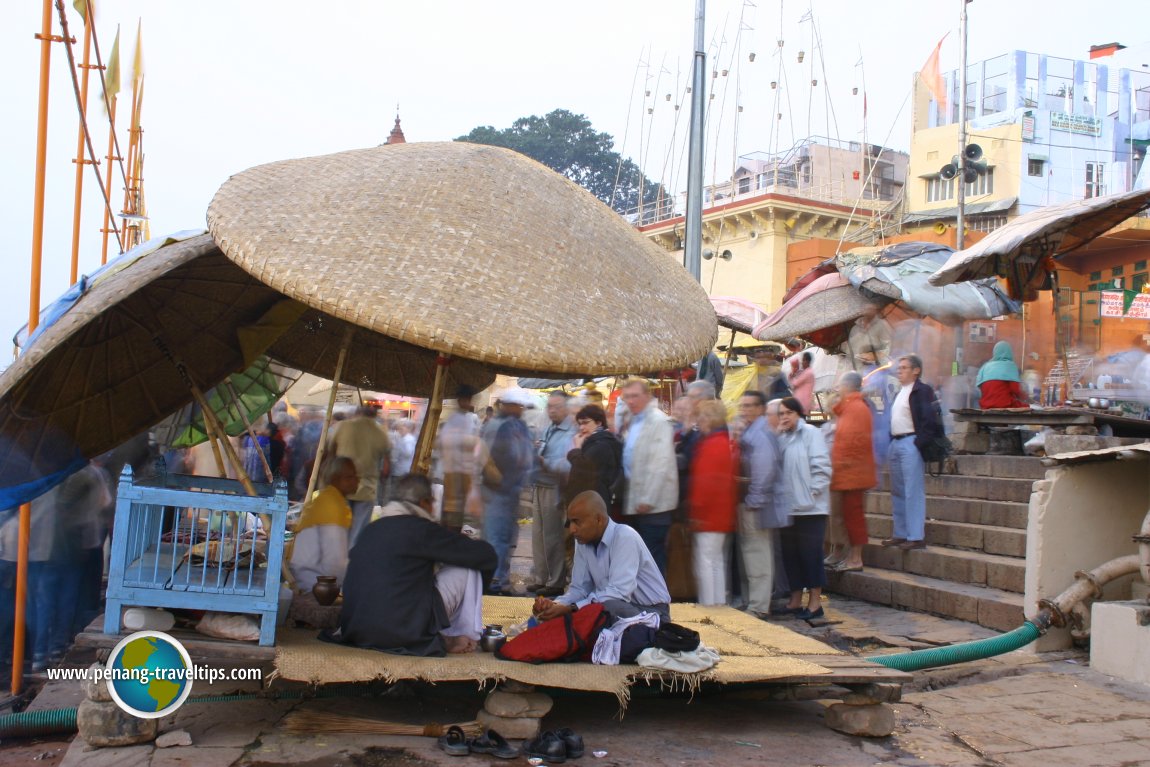 Fortune telling and other trades happen under the parasol beside the Ganges (16 November 2004)
Fortune telling and other trades happen under the parasol beside the Ganges (16 November 2004)
There were people in Varanasi who made it their trade to collect cow dung. I saw a wizened old woman doing just that, by the banks of the Ganges. While the dung was still fresh and warm, she scooped it up using her bare hands into a sort of rattan basket. The dung is then fashioned into dung cakes which she left to bake over the hot cement pavement. By the way, I was watching all this while seated in a restaurant along the riverbank. Luckily I had stronger constitution, otherwise, I'd lose my lunch.
Varanasi is built on a curve on the west bank of the Ganges river. Along this side of the Ganges are close to one hundred ghats. Ghats are staircase going down to the water's edge (the same word is found in Penang and Singapore such as Dhoby Ghaut). This is where you can observe the everyday life of Varanasi, with everything from laundry to cremation being carried out.
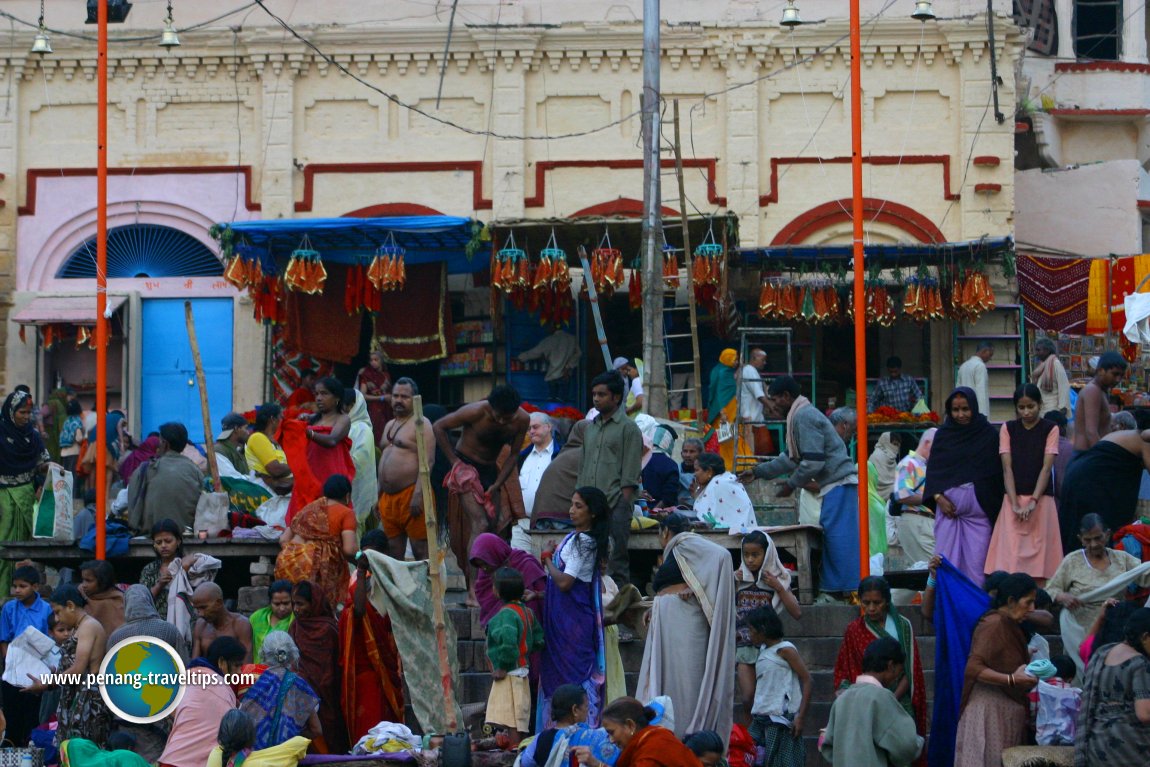 Pilgrims crowding the ghat in Varanasi. (16 November 2004)
Pilgrims crowding the ghat in Varanasi. (16 November 2004)
We woke early every day so that we could catch the sunrise from the ghats. As the first rays of sun illuminated the Varanasi ghats, I watched as thousands of devotees descend into the Ganges for a ceremonial dip. There are worship ceremonies - poojas - being performed twice a day, at dawn and at dusk. These are all great photographic opportunities, and while I try to describe these to you in words, there is nothing like viewing them in person.
On one morning, we hired a boat to take us along the Ganges, and I managed to capture several spectacular shots of the ghats, with the devotees bathing in the holy river, as the sun peeks over the horizon. We also hired the boat to take us around during dusk, and on this instance, we had the opportunity of going near the ghats where cremations took place. Taking photographs is taboo, so I only managed to capture a few shots from a safe and polite distance, and in any case, I am too respectful of the people in mourning to intrude into their most grievous moment.
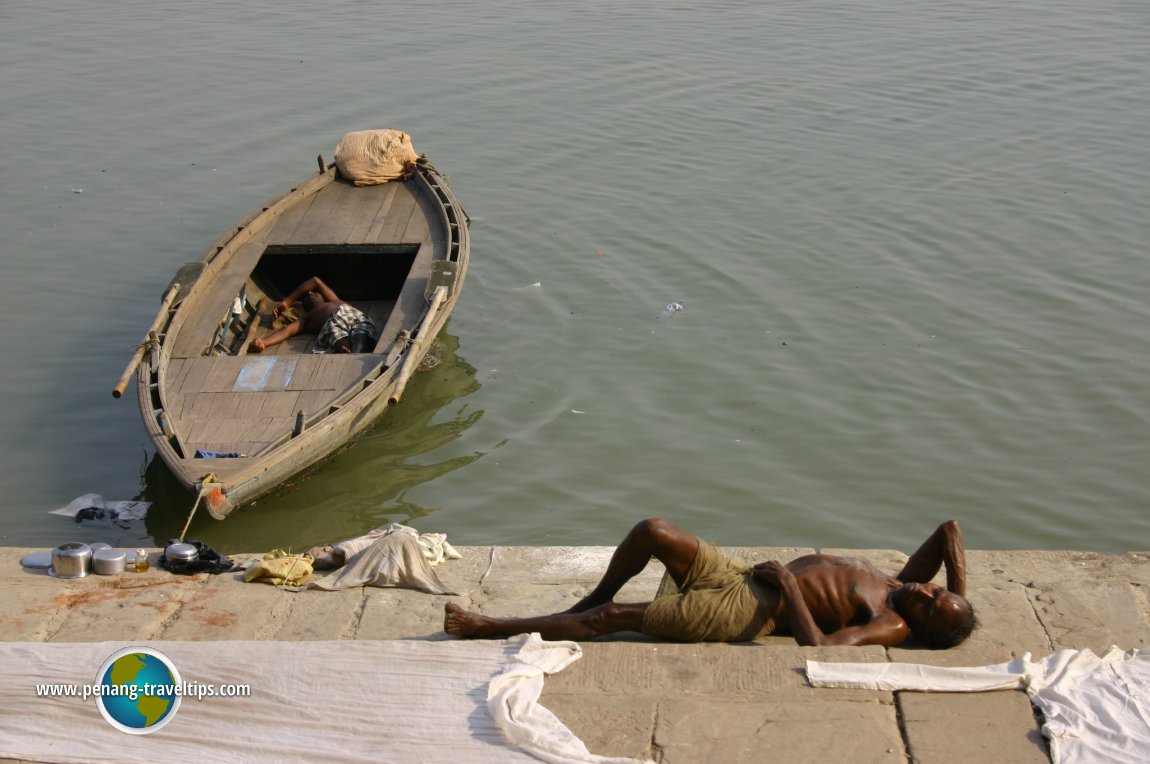 Coolies resting in Varanasi. (17 November 2004)
Coolies resting in Varanasi. (17 November 2004)
I learned that above the ghats where the cremations took place, there are hospices where the terminally ill come, so that they can die in Varanasi, and be cremated in the ghats. I learned that cremation at the ghats is quite an expensive affair, as firewood is becoming scarce, and a great amount is required for a proper cremation. After the cremation is done, the ash is simply tossed into the sacred river. Then, there would be scavengers who dived into the river to salvage the valuables of the deceased. And a short distance from this, you'd find people bathing and washing their clothes. Often, the sight along the Ganges simply render me speechless.
In Varanasi, people are always out to cheat and swindle you, especially if they see you are a foreigner. And they hang around you like glue, pestering and persuading you as if they are so genuine to want to be your friend, until eventually they will start to ask for money, and you see their true colours. It happened to me more than a couple of times in Varanasi, so much so that I got really wary. And weary.
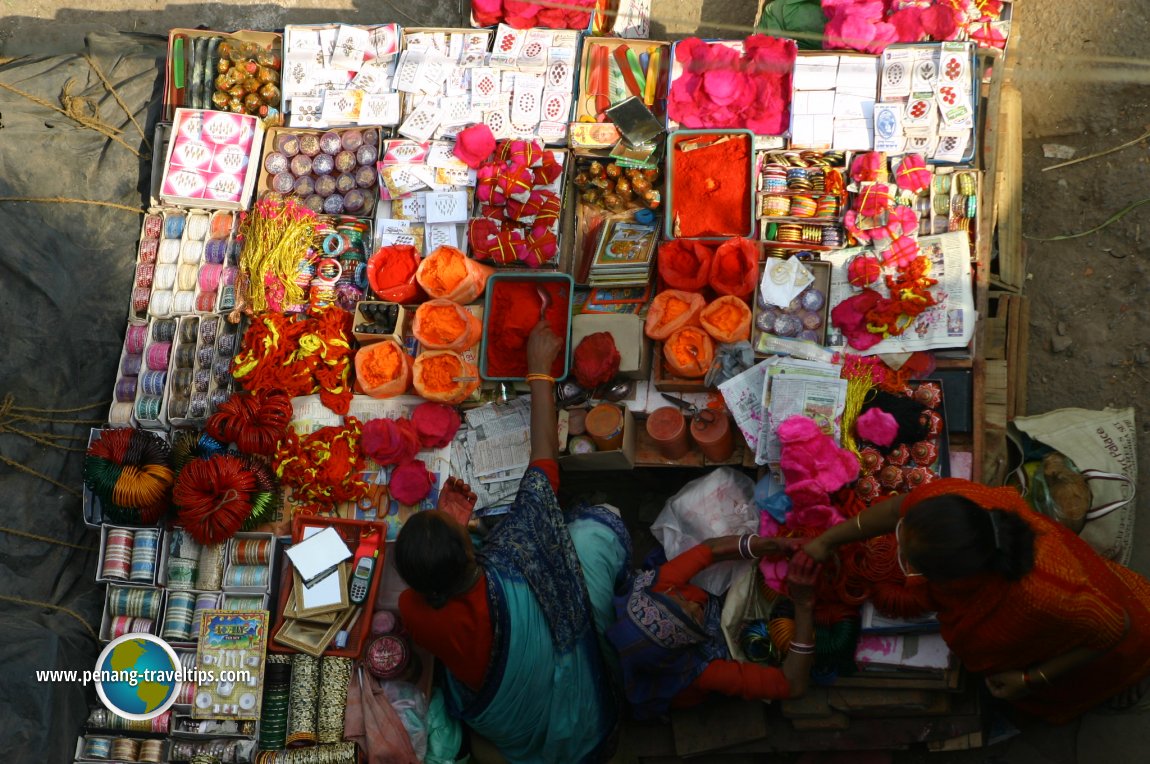 Vendor at a Varanasi market. (17 November 2004)
Vendor at a Varanasi market. (17 November 2004)
During the hot afternoon, I explored the ghats along the Ganges river, with my camera carted over a tripod. I saw how Varanasi carried on the day, with people bathing, repairing boats, scavenging for items in the river, devotees offering prayers at the many riverside temples, people asleep under the shade. I try to capture as much of this city as possible, for I know the likelihood of my returning here for a second visit is rather slim indeed. Varanasi is a great place to visit once, but I don't think I would want to repeat the visit.
To best present this destination in an orderly fashion, I separate my photographs of Varanasi into different categories, as represented by the thumbnails below. Click on any of the thumbnails to view the few days in the life of Varanasi that I managed to capture. I hope the photographs and write-ups will give you a glimpse into this unique Asia destination.
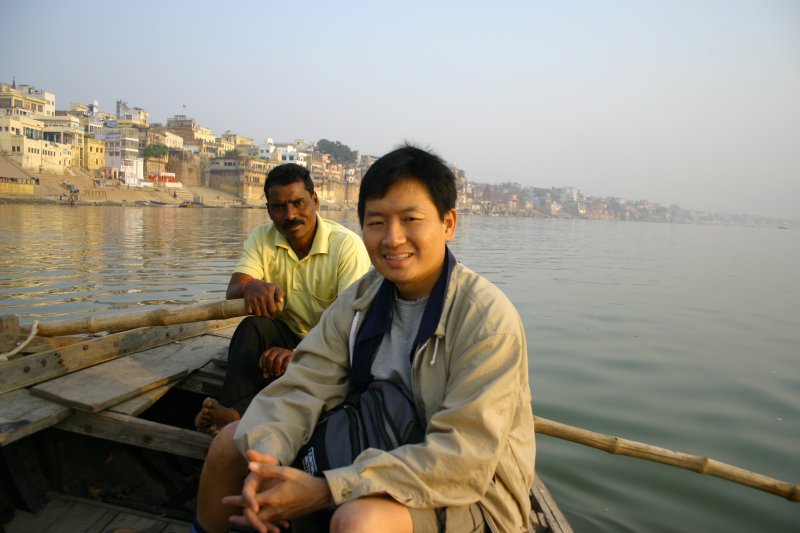 Here I with my boatman on the Ganges in Varanasi. (16 November 2004)
Here I with my boatman on the Ganges in Varanasi. (16 November 2004)
 Latest updates on Penang Travel Tips
Latest updates on Penang Travel Tips
 Share your travels and/or ask a travel-related question
Share your travels and/or ask a travel-related question
Join the Penang Travel Tips Facebook Group to share photos, tips and anything related to your travels, or ask travel-related questions.
 Map of Roads in Penang
Map of Roads in Penang
Looking for information on Penang? Use this Map of Roads in Penang to zoom in on information about Penang, brought to you road by road. Discover with Timothy
Discover with Timothy
Let me take you to explore and discover Penang through my series of walking tours on YouTube. You may use these videos as your virtual tour guide. At the beginning of each video, I provide the starting point coordinates which you may key into your GPS, Google Maps or Waze, to be navigated to where I start the walk, and use the video as your virtual tour guide.Disclaimer
Please use the information on this page as guidance only. The author endeavours to update the information on this page from time to time, but regrets any inaccuracies if there be any.Songs about Penang
About this website

Hello and thanks for reading this page. My name is Timothy and my hobby is in describing places so that I can share the information with the general public. My website has become the go to site for a lot of people including students, teachers, journalists, etc. whenever they seek information on places, particularly those in Malaysia and Singapore. I have been doing this since 5 January 2003, for over twenty years already. You can read about me at Discover Timothy. By now I have compiled information on thousands of places, mostly in Peninsular Malaysia and Singapore, and I continue to add more almost every day. My goal is to describe every street in every town in Malaysia and Singapore.
Copyright © 2003-2024 Timothy Tye. All Rights Reserved.


 Go Back
Go Back